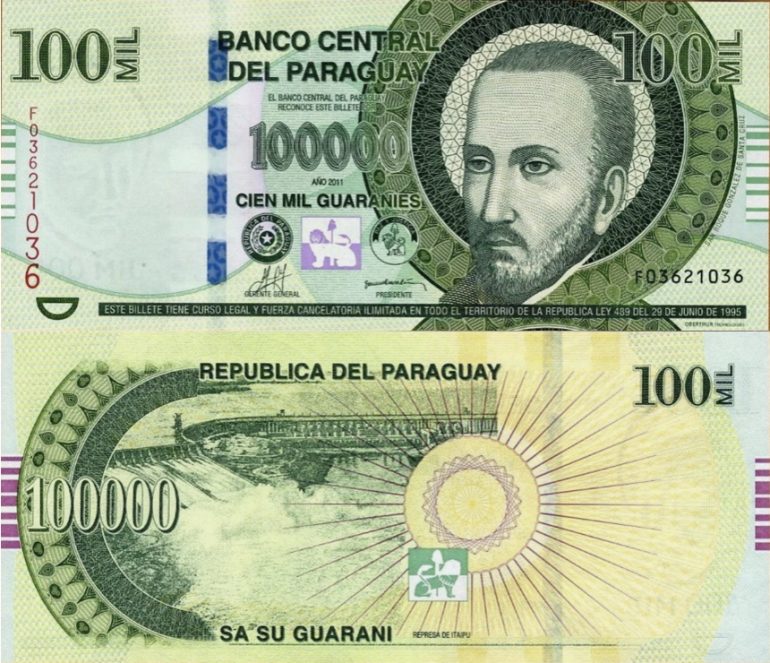Paraguay’s currency tells a story beyond its value. In the weekly series “Money Talks”, The Asunción Times takes readers on a journey through the nation’s Guaraní banknotes. Each edition will explore a different bill, revealing the history, culture, and notable figures depicted on it. The series will also highlight the hidden details that make each note unique. From pioneers of education to national symbols, this series uncovers the stories woven into Paraguay’s money. This week: the story of Saint Roque, the first Paraguayan saint.
Following our look into the iconic mix-up on the Gs. 2,000 banknote, the hidden features of the Gs. 5,000 note, the disputed iconographic mistake of the Gs. 10,000 note, the artistic legacy of the Gs. 20,000 note, and the three intertwined stories behind the four versions of the Gs. 50,000, this week we explore the most emblematic note of all: the Gs. 100,000, a banknote that unites faith, history, and national pride.
The arrival of a new denomination
The first public references to the forthcoming Gs. 100,000 banknote appeared in early 1998, when national authorities began preparing the ground for the introduction of a higher denomination into the economy. According to official information, the note was formally presented on 29 June 1998. The first banknotes entered circulation shortly afterwards, when 400,000 units were released, equivalent to 40,000 million guaraníes.
What is certain is that 1998 marked the debut of the Gs. 100,000 note, which continues to be the highest denomination in Paraguay to this day. At the time of its release, the note held an approximate value of US$37. Today, its value is around US$14 as of 19 November 2025.
A note written in anticipation
The design and printing of the banknote were entrusted to Thomas de la Rue, a British firm recognised internationally for the craft of secure currency. The Gs. 100,000 note introduced a series of refined security elements: intaglio printing that lifts the ink from the paper in a subtle raised texture, revealing hidden images when the note is tilted; a reflective metallic element that catches the light like a quiet signal of authenticity; a multi-redundancy hologram whose shifting patterns protect the note through movement; and specialised anti-photocopy and anti-scanner protections that distort or vanish when duplicated.
Woven into its design is a detail that almost whispers a story of its own. When the note was created, the Paraguayan Central Bank was contemplating the possibility of removing three zeros from the guaraní, a reform that would have redefined the nation’s currency. In anticipation of that imagined future, the note bears the inscription 100 thousand (100 MIL), rather than “100,000”, “so they people get used to seeing less zeroes”.
As is often the case in Paraguay, the public embraced this peculiarity with effortless grace, adapting so naturally that the question of redenomination drifted into the background. Whether that reform will ever come to pass remains unknown, yet the ease with which the nation adjust speaks to a quiet, resilient spirit, carried even in the smallest details of their currency.
Saint Roque: The first Paraguayan saint
The obverse of the note depicts Paraguay’s first canonised saint, Roque González de Santa Cruz, whose image has become inseparable from the identity of the banknote.

Born in Asunción in 1576, Roque González first served as a diocesan priest before entering the Society of Jesus on 9 May 1609. He was martyred on 15 November 1628 in the Jesuit reduction “All Saints of Ka’aro Reduction” (Todos los Santos del Ka’aro), located near the Uruguay River in what is now Rio Grande do Sul, Brazil. According to tradition, although his body was burned, his heart remained intact and was later taken to Rome.
His relics returned to the Americas in 1928. In 1934, Roque González and his companions Alonso Rodríguez and Juan del Castillo were beatified by Pope Pius XI.
On 16 May 1988, during a historic visit to Paraguay, Pope John Paul II canonised the three Jesuit martyrs, describing Roque González as the first saint of the Paraguayan nation.
Since 1998, the face of Saint Roque, Paraguay’s first saint, has been permanently featured on the country’s highest-value banknote.
Itaipú Binacional: A national symbol

The reverse of the banknote features the Itaipú Dam, one of the world’s largest hydroelectric projects. Brazil and Paraguay signed the Itaipú Treaty on 26 April 1973, establishing the legal framework for the joint use of the Paraná River. The Itaipú Binational Entity was created in 1974 to manage construction, and the dam began generating electricity in May 1984.
Its appearance on the banknote highlights its importance as a symbol of national development and binational cooperation.
Ink, Faith, and Nation
Far more than a financial instrument, the Gs. 100,000 carries the spirit of Paraguay within its folds. On one side, San Roque González de Santa Cruz embodies a nation where faith does not merely belong to the past, but continues to guide daily life with quiet conviction.
On the other, the Itaipú Dam rises as a testament to human endeavour and collective pride, a reminder that Paraguay’s strength lies not only in its spiritual roots, but also in its capacity to shape the future with vision and determination.
Together, saint and dam form a powerful dual emblem: a union of soul and progress. In this way, the country’s highest denomination becomes more than currency. It becomes a piece of shared memory, a paper fragment of who Paraguay has been, and who it aspires to be.


